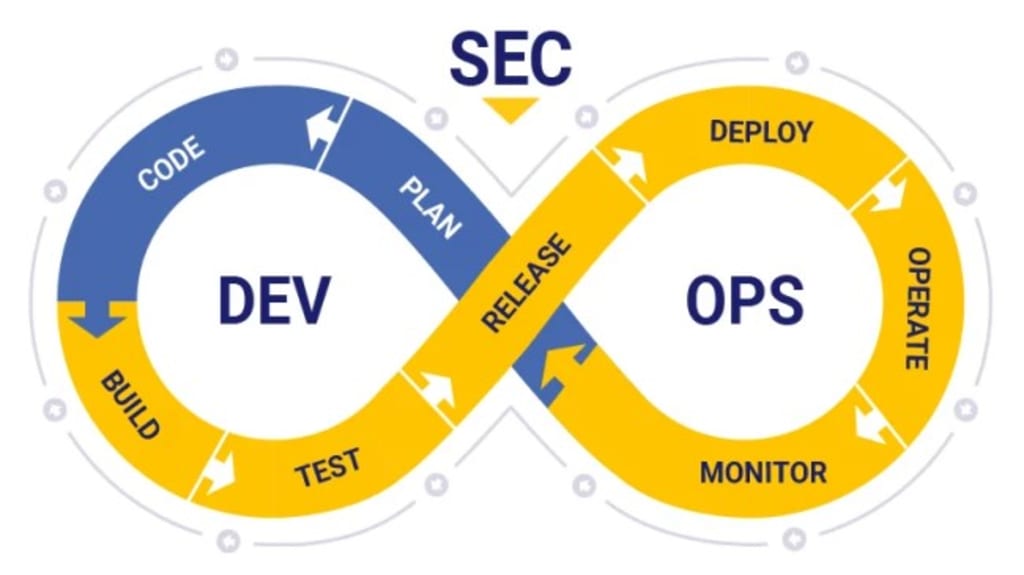Achieving DevSecOps Success: Challenges and Best Practices
Addressing Challenges & Best Practices in DevSecOps Adoption

DevSecOps, is a powerful approach that stresses integrating security practices early and consistently throughout the software development process. It brings together development, security, and operations. Today, we'll tell you that why it's crucial for organizations to adopt DevSecOps best practices to strengthen security in their software development processes.
Understanding the Delay in Security Integration
Even though DevOps has gained widespread adoption in driving software development, the integration of security measures has been slow. This delay often arises from differences in goals, priorities, and metrics within organizations. Security tends to be overlooked when it's not a significant part of how success is measured. Also, breaking down the walls between traditionally separate security and DevOps teams is crucial for smooth integration. Achieving DevSecOps best practices means making a real effort to bridge these gaps.
Dealing with cultural resistance by getting leaders on board and running advocacy programs can speed up the integration of security into DevOps practices. By helping everyone understand the benefits of DevSecOps and aligning goals with what the organization wants to achieve, leaders can encourage a proactive approach to security integration. Providing resources and support for skills development helps teams get the skills they need to put security best practices into action. Embracing DevSecOps becomes easier when there's a culture of constant learning and adaptation.
Bridging Among DevOps and Security Teams
Collaboration between DevOps and security teams is essential for establishing a robust security approach. Incorporating strategies such as integrating security reviews into the development process via pull requests and cross-team assignments can enhance mutual understanding of each other's goals. Achieving DevSecOps best practices means breaking down barriers and sharing responsibility.
Setting up a shared knowledge base that documents security requirements, DevSecOps best practices, and lessons learned makes it easier to share knowledge and understand security goals. Regular joint training sessions and workshops give teams a chance to work together and learn from each other's expertise. Participating in joint exercises to respond to security incidents enhances team cohesion, especially during high-pressure situations. DevSecOps flourishes when everyone collaborates and shares their expertise.
Control and Automation
One major challenge in DevSecOps is the shift in control, especially tough for security teams used to being in charge. Embracing automation is crucial for making security efforts bigger and faster. Even though there might be some resistance at first, automating security testing and policies makes it easier for teams to work together and makes security better overall. Achieving DevSecOps best practices means switching to automated ways of doing things.
Investing in good automation tools that are made for DevSecOps teams is important for getting the most out of them. Using infrastructure-as-code (IaC) principles lets organizations write down security settings and make sure they're the same every time. Using automated tools for scanning for vulnerabilities and managing patches helps organizations stay on top of new threats.
Speed and Risk Management
Speed matters in modern software development, yet so does caution. Automation helps in both aspects by facilitating problem-solving while maintaining a swift pace. By automating security testing and fixing problems, security teams can focus on big problems and keep everything running smoothly. Achieving DevSecOps best practices means finding the right balance between speed and security.
Putting automated security checks into the development process at every step lets organizations catch problems early. Putting security controls right into the process of deploying software means that security is always being thought about. Having a way to automatically undo changes if something goes wrong makes sure that nothing bad gets through. DevSecOps makes sure that security is always being looked after.
Enhancing Observability for Effective Security
Being able to see what's going on is really important for DevSecOps because it helps organizations find and fix problems before they become big. By watching everything that's happening during the software development process, organizations can make sure that everything's going well. Having a clear view of what's happening is key in complex systems like Kubernetes. It helps organizations prevent problems before they occur. Following DevSecOps best practices means being able to quickly respond when something goes wron..
Using tools that keep track of everything makes it easier to see when something's not right. Being able to follow what's happening across a complicated system helps organizations see where problems might come from. Having dashboards that show what's happening and let teams know when there's a problem helps everyone work together. DevSecOps needs everyone to be watching out for problems.
Alert Fatigue Due to Automation and Contextual Understanding
Having lots of alerts can be confusing when trying to spot real problems. Automation helps by sorting out what matters most. Ensuring only crucial alerts come through and fixing them promptly ensures smooth operations and prevents mishaps. Knowing what's important helps teams use their time better. Achieving DevSecOps best practices means finding the right balance between automation and human understanding.
Using computers to look at old alerts and figure out what's important helps organizations stop things from going wrong. Using information about what's happening around the world to understand what's going on makes it easier to tell when something's wrong. Having plans for what to do when something goes wrong and using computers to make sure that they happen the way they should means that things get fixed quickly. DevSecOps makes sure that everyone knows what to do when there's a problem.
Legislation and Regulation in DevSecOps
Organizations must stay vigilant with constantly changing security regulations. Ensuring that tasks are carried out correctly not only enhances safety but also streamlines operations. Making sure that everyone knows what's going on and that everything's being done the way it should be is really important. Achieving DevSecOps best practices means doing everything the right way.
Endnote
Talking to lawyers and people who know about rules early on helps organizations understand what they have to do. Leveraging computers to ensure compliance and communication simplifies rule adherence. Tracking and demonstrating correct execution streamline compliance. DevSecOps guarantees proper procedures are followed.
About the Creator
Michael Brown
I'm Michael Brown, a passionate advocate for the written word. As part of Bellevue Publishers, an innovative book publishing company, I am dedicated to amplifying unique voices and sharing impactful stories with the world.
Enjoyed the story? Support the Creator.
Subscribe for free to receive all their stories in your feed. You could also pledge your support or give them a one-off tip, letting them know you appreciate their work.






Comments
There are no comments for this story
Be the first to respond and start the conversation.